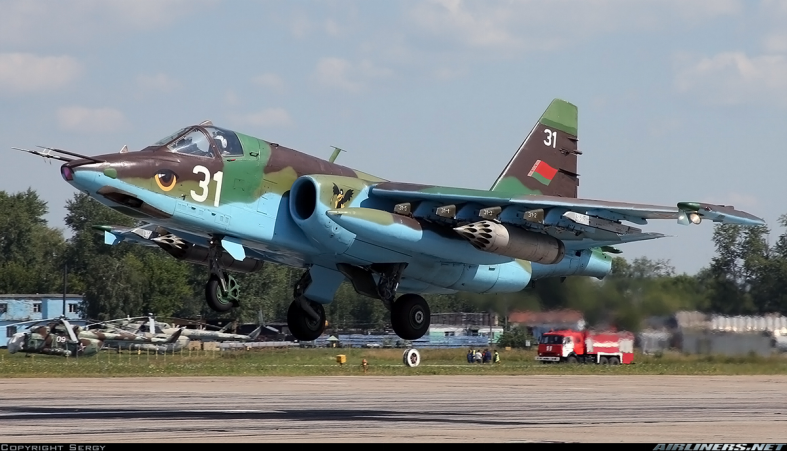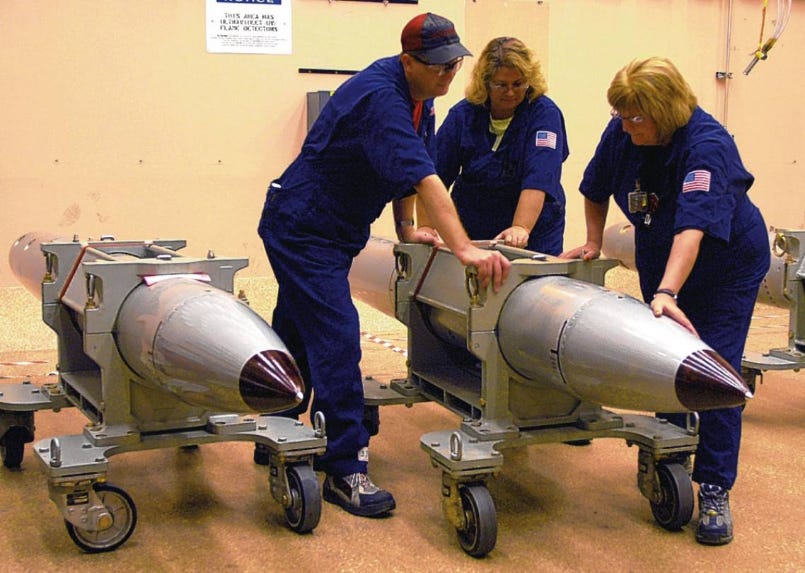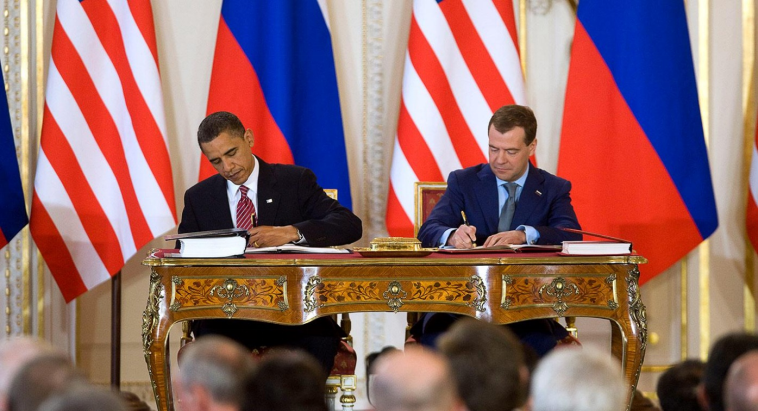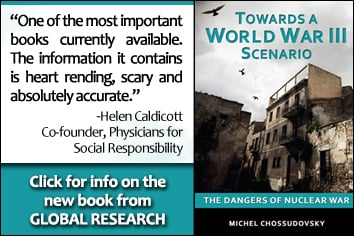It’s the End of the World As We Know It. The American-NATO Rush Toward Nuclear War with Russia. Scott Ritter

All Global Research articles can be read in 51 languages by activating the Translate Website button below the author’s name (only available in desktop version).
To receive Global Research’s Daily Newsletter (selected articles), click here.
Click the share button above to email/forward this article to your friends and colleagues. Follow us on Instagram and Twitter and subscribe to our Telegram Channel. Feel free to repost and share widely Global Research articles.
Give Truth a Chance. Secure Your Access to Unchained News, Donate to Global Research.
First published by Global Research on 24 June 2024
***
America’s addiction to nuclear weapons does not lend itself to deterrence-based stability. It only leads to war.
“That’s great, it starts with an earthquake…”
There’s nothing like a classic 1980’s rock song to get one’s blood up and running, and REM’s 1987 classic, It’s the End of the World as We Know It (And I Feel Fine), fits the bill just right on this hot and muggy summer day.
The only problem is, the song might as well be prophesy, because from where I sit, taking in the news about the rapidly escalating nuclear arms race between the United States and Russia, it very much looks like the end of the world as we know it.
And I don’t feel fine.
The news isn’t good. Last month, on May 6, the Russian Ministry of Defense announced that it would, on the orders of Russian President Vladimir Putin, conduct exercises involving the use of non-strategic nuclear weapons. According to Russian officials, the exercises were a response to “provocative statements and threats from certain Western officials directed at the Russian Federation.”
The Russians were responding to statements made by French President Emmanuel Macron to The Economist on May 2, where he declared that
“I’m not ruling anything out [when it comes to deploying French troops to Ukraine], because we are facing someone [Putin] who is not ruling anything out.” Macron added that “if Russia decided to go further [advancing in Ukraine], we will in any case all have to ask ourselves this question (whether to send of troops).”
While Macron described his remarks as a “strategic wake-up call for my counterparts,” it was clear not everyone was buying into what he was selling. “If a NATO member commits ground troops [to Ukraine],” Hungarian Foreign Minister Peter Szijjarto said after Macron’s words became public, “it will be a direct NATO-Russia confrontation, and then it will be World War III.”
The Russians conducted their exercises in two phases, with the first taking place in late May. There, the tactical missile forces of the Southern Military District practiced “the task of obtaining special training ammunition for the Iskander tactical missile system, equipping them with launch vehicles and secretly moving to the designated position area to prepare for missile launches.”
The Iskander-M is the nuclear-capable version of the Iskander family of missiles and can carry a single nuclear warhead with a variable yield of between 5 and 50 kilotons. (By way of comparison, the American atomic bomb dropped on Hiroshima had a yield of 15 kilotons.) The single-stage solid rocket missile flies at high hypersonic speeds, and possesses a maneuvering warhead, making it virtually impossible to shoot down. With a range of 500 kilometers, the Iskander-M, when fired from locations in Crimea, would be able to reach French bases located in Romania, which ostensibly would be used to surge forces into Ukraine.
The second phase of the exercises took place on June 10, when the Russian and Belorussian forces practiced the transfer of Russian nuclear weapons to Belorussian control as part of the new Russian nuclear sharing doctrine put in place by Vladimir Putin and his Belorussian counterpart, Alexander Lukashenko, earlier this year. The weapons involved included the Iskander-M missile and gravity bombs that would be delivered by modified Belorussian SU-25 aircraft. The weapons would put all of Poland and the Baltic States under the threat of nuclear attack.

Belorussian SU-25 aircraft
Around the same time that Russia was carrying out its tactical nuclear drills, several NATO nations, including Germany, announced that they had given Ukraine the green light to use weapons it had provided to strike targets inside Russia. NATO Secretary General Jens Stoltenberg, speaking on the sidelines of a NATO foreign ministers meeting in Prague on May 29, said Ukraine had the right to strike legitimate military targets inside Russia.
“Ukraine has the right for self-defense,” Stoltenberg declared, adding that “we have the right to help Ukraine uphold the right for self-defense, and that does not make NATO allies a party to the conflict.”
Putin took time from his visit to Uzbekistan to reply, warning that NATO members in Europe were playing with fire by proposing to let Ukraine use Western weapons to strike deep inside Russia. Putin said Ukrainian strikes on Russia with long-range weapons would need Western satellite, intelligence and military assistance, thus making any Western help in this regard a direct participant in the conflict.
“Constant escalation can lead to serious consequences,” Putin said. “If these serious consequences occur in Europe, how will the United States behave, bearing in mind our parity in the field of strategic weapons? It’s hard to say,” Putin said, answering his own question. “Do they want a global conflict?”
On June 5, speaking to an audience of senior editors of international news agencies while attending the Saint Petersburg International Economic Forum, Putin observed that,
“For some reason, the West believes that Russia will never use it [nuclear weapons]. We have a nuclear doctrine,” Putin noted. “Look what it says. If someone’s actions threaten our sovereignty and territorial integrity, we consider it possible for us to use all means at our disposal. This should not be taken lightly, superficially.”
But the US and NATO were doing just that. In an interview to the British Telegraph newspaper given at NATO’s headquarters building in Brussels, Belgium, Stoltenberg said that NATO members were consulting about deploying more nuclear weapons, taking them out of storage and placing them on standby in the face of a growing threat from Russia and China.
“I won’t go into operational details about how many nuclear warheads should be operational and which should be stored, but we need to consult on these issues,” Stoltenberg said.

American technicians with a pair of B61 nuclear bombs
The only nuclear weapons currently in the NATO system are some 150 US-controlled B61 gravity bombs stored at six NATO bases: Kleine Brogel in Belgium, Büchel Air Base in Germany, Aviano and Ghedi Air Base in Italy, Volkel Air Base in the Netherlands and Incirlik in Turkey. NATO officials later clarified Stoltenberg’s remarks, saying there were no significant changes to the NATO nuclear posture, noting that Stoltenberg’s comments referred to the modernization of NATO’s nuclear deterrent, including the replacement of F-16 jets with F-35 stealth fighters, and the modernization of some of the B61 bombs currently deployed in Europe.
Stoltenberg’s comments to the Telegraph came 10 days after Pranay Vaddi, the senior director for arms control at the National Security Council, announced a “new era” for nuclear arms in which the US would deploy nuclear weapons “without numerical constraints.”
Stoltenberg’s statements, when viewed in the context of Vaddi’s declaration, points to a dangerous shift in focus within both NATO and the US away from the concept of nuclear weapons representing a force of deterrence, and instead increasingly being seen in the West as a usable weapon of war.
The concept of deterrence as the sole justification for the existence of nuclear weapons dates back to 1978, when the United Nations General Assembly held its first Special Session on Disarmament. One of the main ideas to emerge from this event was the notion of so-called negative security assurances, or NSAs, in which the declared nuclear-armed states committed to not using nuclear weapons against non-nuclear weapon states that were in good standing with the Non-Proliferation Treaty (NPT) and not otherwise aligned with a nuclear-armed state.
These NSAs furthered the notion of nuclear deterrence as a formal binding doctrine among nuclear-armed states, operating on the idea that since nuclear weapons could only be used against a nuclear-armed state, and that any such use would lead to the mutual destruction of the involved parties, therefore the only rational purpose for the existence of nuclear weapons was to deter those nations that also possessed them from ever using them in the first place.
From this foundational understanding emerged modern concepts of nuclear disarmament which framed the arms control policies of the United States and the Soviet Union that emerged in the 1980’s and 1990’s—since the sole purpose of nuclear weapons was deterrence, it was in the best interest of all parties to a) significantly reduce their respective nuclear arsenals and b) implement policies designed to normalize relations to the point that nuclear arsenals became moot.

Barack Obama and Dmitry Medvedev sign the New START Treaty in 2010
The collapse of the Soviet Union in 1991, however, ushered in a new post-Cold War reality which saw the notion of a nuclear “balance” where the US and Soviets operated as equals being replaced by a doctrine of “managed supremacy” which saw the US use the mechanisms of arms control and disarmament to promote and sustain its position as the world’s dominant nuclear power. Arms control ceased being a concept premised on equitable deterrence, and instead became a tool designed to subordinate the nuclear capabilities of the Russian Federation that emerged from the ashes of the Soviet Empire to those of the newly-minted American hegemon.
The US began deconstructing the foundation of arms control treaties that had been negotiated on the premise of sustaining a nuclear deterrence-based balance of power, first by using the Strategic Arms Reduction Treaty (START) process as a mechanism to promote the unilateral disarmament of the Russian strategic arsenal, and later by withdrawing from the Anti-Ballistic Missile (ABM) treaty that had served as the foundational agreement around which the concept of mutually assured destruction (MAD) was framed.
Deterrence theory is viable only so long as MAD is viewed as the inevitable outcome of any nuclear conflict. By re-embracing the notion of viable ballistic missile defense, the US undermined the premise enshrined in MAD, namely that to use nuclear weapons was to invite your own demise. The US now operated in a world where it embraced deterrence theory only in so far as it deterred other nations from attacking the US with nuclear weapons. From the US perspective, assured destruction was a dated notion, one that was replaced by the concept of a “winnable” nuclear war.
The proactive utility of nuclear weapons form the standpoint of US nuclear doctrine, as expressed in the US Nuclear Posture Review (NPR) of 2010, where the US, while continuing to commit not to “use, or threaten to use, nuclear weapons against [NPT-compliant] non-nuclear-weapon states,” declared that “there remains a narrow range of contingencies in which US nuclear weapons may still play a role in deterring a conventional or [chemical and biological weapons] attack.”
Subsequent NPRs have expanded on this notion, incorporating the possibility of US nuclear retaliation against cyber attacks and other non-WMD linked events. The proactive nature of the US nuclear posture was such that when a senior Trump administration official involved in making nuclear policy declared that the goal of the administration of President Donald Trump was to have the Chinese and Russians waking up every morning not knowing whether of not “this was the day the US nuked them,” one simply could not write off the statement as ill-conceived hyperbole, but rather recognize it as part and parcel of ill-conceived nuclear policy.
Russian President Vladimir Putin, however, is not one to wake up in the morning afraid of a potential US nuclear attack. Speaking recently from Hanoi, Putin said “They [the US and NATO] seem to think that at some point we will get scared. But at the same time, they also say they want to achieve a strategic defeat of Russia on the battlefield.” Putin then ominously remarked that, “It means the end of the 1,000-year history of the Russian state. I think this is clear to everyone. Isn’t it better to go all the way, until the end?”
Accusing the West of “lowering the threshold” for the use of nuclear weapons against Russia, Putin declared that Russia must now reconsider its own nuclear posture considering NATO’s apparent willingness to make operational tactical nuclear weapons—a clear reference to Jens Stoltenberg’s June 16 comments. Russia last published its nuclear weapons doctrine, formally known as “Basic Principles of State Policy on Nuclear Deterrence,” in 2020. This doctrine declares that Russia could use nuclear weapons if an enemy “threatened the existence of the Russian state” in response to an enemy’s use of weapons of mass destruction against Russia or its allies, or if Russia received credible information that a nuclear strike was being planned or about to take place.
Putin, in his Hanoi remarks, downplayed the notion of Russia embracing a policy of nuclear preemption. “We don’t need a preventive strike,” Putin said, “because with a retaliatory strike the enemy is guaranteed to be destroyed.”
When asked by reporters whether Ukraine’s use of Western long-range weapons against Russian territory could be considered an act of aggression and a direct threat to the Russian state, Putin replied “This requires additional research, but it’s close.”
Too damn close.
The United States and Russia are drifting closer and closer to all-out nuclear war. It is high time that the people who would pay the ultimate price for such folly decide, to borrow from the poetry of Dylan Thomas, if they want to go “gently into the night” of nuclear Armageddon, or instead “rage, rage against the dying of the light” by demanding better policy from their respective governments.
As for me, I choose rage.
There will be an event dedicated to stopping this mad rush toward on September 28, in Kingston, New York. Gerald Celente is putting this together, along with a coalition of like-minded citizen patriots.
We hope to organize sister events in cities across the country.
We want to put more than a million Americans into the streets that day, focused on one thing and one thing only—stop the madness of nuclear war.
Will you join us?
Or will you stay at home and listen to the music of the collective versions of modern-day Nero’s, fiddling while America and the rest of the world burns.
You vitriolic, patriotic, slam fight, bright light
Feeling pretty psyched
It’s the end of the world as we know it…
But not if I can help it.
*
Note to readers: Please click the share button above. Follow us on Instagram and Twitter and subscribe to our Telegram Channel. Feel free to repost and share widely Global Research articles.
Featured image: Russian Iskander-M nuclear missile (Source: Scott Ritter Extra)
 “Towards a World War III Scenario: The Dangers of Nuclear War”
“Towards a World War III Scenario: The Dangers of Nuclear War”
by Michel Chossudovsky
Available to order from Global Research!
ISBN Number: 978-0-9737147-5-3
Year: 2012
Pages: 102
PDF Edition: $6.50 (sent directly to your email account!)
Michel Chossudovsky is Professor of Economics at the University of Ottawa and Director of the Centre for Research on Globalization (CRG), which hosts the critically acclaimed website www.globalresearch.ca . He is a contributor to the Encyclopedia Britannica. His writings have been translated into more than 20 languages.
Reviews
“This book is a ‘must’ resource – a richly documented and systematic diagnosis of the supremely pathological geo-strategic planning of US wars since ‘9-11’ against non-nuclear countries to seize their oil fields and resources under cover of ‘freedom and democracy’.”
–John McMurtry, Professor of Philosophy, Guelph University
“In a world where engineered, pre-emptive, or more fashionably “humanitarian” wars of aggression have become the norm, this challenging book may be our final wake-up call.”
-Denis Halliday, Former Assistant Secretary General of the United Nations
Michel Chossudovsky exposes the insanity of our privatized war machine. Iran is being targeted with nuclear weapons as part of a war agenda built on distortions and lies for the purpose of private profit. The real aims are oil, financial hegemony and global control. The price could be nuclear holocaust. When weapons become the hottest export of the world’s only superpower, and diplomats work as salesmen for the defense industry, the whole world is recklessly endangered. If we must have a military, it belongs entirely in the public sector. No one should profit from mass death and destruction.
–Ellen Brown, author of ‘Web of Debt’ and president of the Public Banking Institute

